Fernando de Valenzuela, 1st Marquis of Villasierra facts for kids
Quick facts for kids
Don
Fernando de Valenzuela, 1st Marquis of Villasierra
|
|
|---|---|

Fernando de Valenzuela, 1st Marquis of Villasierra, ca 1660
|
|
| Chief Minister | |
| In office November 1676 – January 1677 |
|
| Monarch | Charles II, King of Spain |
| Preceded by | Juan Everardo Nithard |
| Succeeded by | John of Austria the Younger |
| Captain-General of Granada | |
| In office May 1676 – October 1676 |
|
| Personal details | |
| Born | 8 January 1636 Naples |
| Died | 7 February 1692 (aged 56) Mexico City |
| Nationality | Spanish |
| Spouse | Maria Ambrosia de Ucedo y Prado |
| Children | Francisco de Valenzuela y Ucedo (1670-?) |
| Parents | Francisco de Valenzuela Leonora de Encisa |
| Awards | Order of Santiago 1671 |
Fernando de Valenzuela, 1st Marquis of Villasierra, also known as a Grandee of Spain, was an important advisor to Mariana of Austria, who was the Queen Regent of Spain. He was born in Naples on January 8, 1636, and passed away on February 7, 1692.
Valenzuela came from a family of lower-ranking Spanish nobles called hidalgos. Because of this, many of the powerful upper nobles, known as grandees, did not like his appointment to high government positions. In 1677, he was removed from his job and sent to prison in the Philippines. He was set free in 1688 and moved to Mexico City, where he lived until his death in 1692.
Contents
Fernando Valenzuela's Early Life
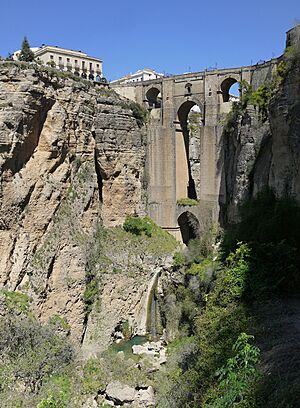
Fernando de Valenzuela was born in Naples in 1636. He was the only son of Francisco de Valenzuela and Leonora de Encisa y Davila. He was baptized on January 17, 1636, in a church called Sant'Anna dei Lombardi.
His family, the Valenzuelas, were from Andalusia in Southern Spain. They were middle-ranking nobles, or hidalgos, who worked as soldiers and administrators across the large Spanish Empire. In 1485, during a time called the Reconquista, Fernando's ancestor, Fernando de Valenzuela Baena, helped capture the city of Ronda. For his efforts, he received land and important jobs. The family remained well-known in the area.
In 1661, Fernando Valenzuela married Maria Ambrosia de Ucedo y Prado. Their son, Francisco de Ucedo de la Valenzuela, later became a government officer in the Mexican provinces of Nueva Vizcaya and New Navarre.
Fernando Valenzuela's Career and Rise to Power
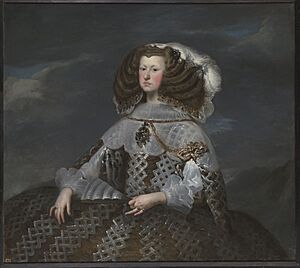
Fernando's father, Francisco de Valenzuela, left Ronda after an incident, though the details are not clear. He served in the Spanish army in Flanders and Milan. Later, he settled in the Kingdom of Naples, which was then part of the Crown of Aragon. Francisco became Governor of Sant'Agata, a town in the Province of Naples.
After his father died in 1640, Fernando's mother, Leonora, returned to Madrid. She helped her son get a job as a page in the household of the Duke of Infantado. Fernando worked for the Duke from 1648 to 1655. During this time, the Duke served as an ambassador, governor, and viceroy before retiring.
Valenzuela also served in the Spanish army in Italy, but his career wasn't moving forward. So, he returned to Madrid in 1659. Two years later, he married Maria Ambrosia de Uceda. She was a lady-in-waiting to Mariana of Austria. As a wedding gift, Mariana gave Valenzuela a job in her royal household.
When King Philip IV died in 1665, his son Charles II was only three years old. Mariana was made regent by the Council of Castile, meaning she would rule until Charles was old enough. The next ten years were filled with power struggles between Mariana and Charles's half-brother, John of Austria the Younger.
The Role of a Trusted Advisor
As governing became more complicated, rulers often needed help. They relied on trusted advisors known as validos or privados. This role was similar to a chief minister or a close friend who helps make important decisions. In Spain, this role was used from the 15th to the late 18th century.
Mariana relied on a small group of loyal people who owed their success to her. These included Valenzuela and her personal confessor, Juan Everardo Nithard.
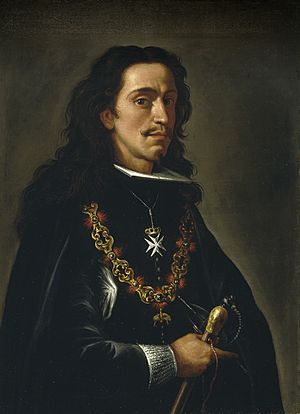
After Nithard left his position in 1669, Valenzuela became more important. In 1671, he was made a knight of the Order of Santiago. He was also appointed 'Introducer of Ambassadors'. This job involved organizing official events and ceremonies related to Spain's foreign policy.
In 1673, Valenzuela became the Queen's Master of Horse. This was a very important job that controlled royal travel, security, and public events. He was in charge of building projects, like expanding the Royal Palace of El Pardo, and organizing sports and hunting trips for King Charles. These high-ranking jobs were usually held by grandees, the highest nobles. Because Valenzuela was from a lower noble family, many grandees were very unhappy about his rise to power.
Valenzuela's Downfall and Exile
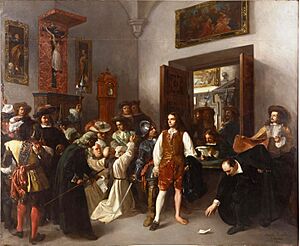
When King Charles turned 14 in 1675, the regency officially ended. However, the Council of Castile agreed that Charles's health meant Mariana still needed to make decisions. John of Austria was sent away to deal with a revolt in Sicily. Valenzuela was made Marquis of Villasierra and Ambassador to Venice, but he stayed in Spain as Captain-General of Granada.
In June 1676, Valenzuela was called back and made Master of Horse for the Royal Household again. This was another job usually held by a grandee. To calm the complaints, Mariana made him a grandee and then her first minister in November. This was too much for the other nobles. On December 24, a group of senior nobles spoke out against the government.
John of Austria was invited to take over. In January 1677, he entered Madrid with 15,000 soldiers. Mariana was sent to a convent in Toledo. Valenzuela lost his titles and property. He was sent away to the Philippines and held in Fort San Felipe.
After John of Austria died in 1679, Mariana regained some power, but Valenzuela was not called back to Spain. He stayed in the Philippines until September 1688. Then, he was allowed to move to Mexico City. The Viceroy of New Spain was a relative of Valenzuela's old boss, the Duke of Infantado. With his help, Valenzuela received a pension and lived comfortably. His title was given back, but not his grandeeship. His properties were returned to his wife in January 1689. Fernando de Valenzuela died on February 7, 1692, after being kicked by a horse.
Fernando Valenzuela's Legacy
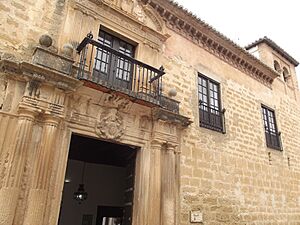
The Palacio de Mondragón in Ronda is also known as the Palacio del Marqués de Villasierra. It was originally built by the Nasrid rulers. Fernando de Valenzuela Baena, an ancestor of Fernando, greatly changed and improved it. The palace later left the family but was bought back by Fernando's great-great-grandson in 1675. Today, it is the town museum.
Some people have suggested that Fernando de Valenzuela inspired the play Ruy Blas by Victor Hugo in 1838. However, Hugo himself said he got his ideas from other stories.
See also
 In Spanish: Fernando de Valenzuela para niños
In Spanish: Fernando de Valenzuela para niños

